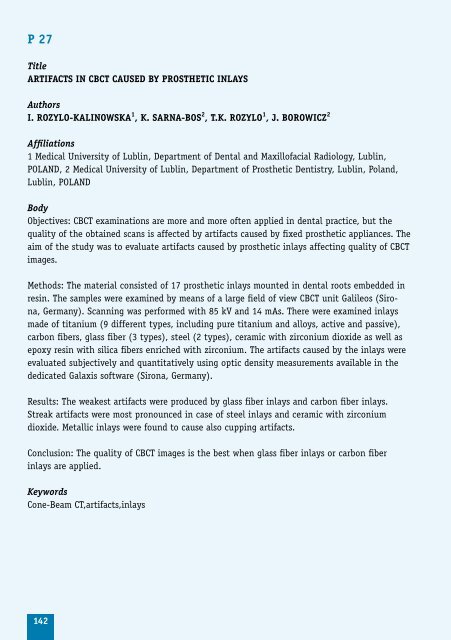Program including abstracts as pdf available here
Program including abstracts as pdf available here
Program including abstracts as pdf available here
Create successful ePaper yourself
Turn your PDF publications into a flip-book with our unique Google optimized e-Paper software.
P 27<br />
Title<br />
ARTIFACTS IN CbCT CAuSED by PROSTHETIC INLAyS<br />
Authors<br />
I. ROzyLO-KALINOWSKA 1 , K. SARNA-bOS 2 , T.K. ROzyLO 1 , J. bOROWICz 2<br />
Affiliations<br />
1 Medical University of Lublin, Department of Dental and Maxillofacial Radiology, Lublin,<br />
POLAND, 2 Medical University of Lublin, Department of Prosthetic Dentistry, Lublin, Poland,<br />
Lublin, POLAND<br />
Body<br />
Objectives: CBCT examinations are more and more often applied in dental practice, but the<br />
quality of the obtained scans is affected by artifacts caused by fixed prosthetic appliances. The<br />
aim of the study w<strong>as</strong> to evaluate artifacts caused by prosthetic inlays affecting quality of CBCT<br />
images.<br />
Methods: The material consisted of 17 prosthetic inlays mounted in dental roots embedded in<br />
resin. The samples were examined by means of a large field of view CBCT unit Galileos (Sirona,<br />
Germany). Scanning w<strong>as</strong> performed with 85 kV and 14 mAs. T<strong>here</strong> were examined inlays<br />
made of titanium (9 different types, <strong>including</strong> pure titanium and alloys, active and p<strong>as</strong>sive),<br />
carbon fibers, gl<strong>as</strong>s fiber (3 types), steel (2 types), ceramic with zirconium dioxide <strong>as</strong> well <strong>as</strong><br />
epoxy resin with silica fibers enriched with zirconium. The artifacts caused by the inlays were<br />
evaluated subjectively and quantitatively using optic density me<strong>as</strong>urements <strong>available</strong> in the<br />
dedicated Galaxis software (Sirona, Germany).<br />
Results: The weakest artifacts were produced by gl<strong>as</strong>s fiber inlays and carbon fiber inlays.<br />
Streak artifacts were most pronounced in c<strong>as</strong>e of steel inlays and ceramic with zirconium<br />
dioxide. Metallic inlays were found to cause also cupping artifacts.<br />
Conclusion: The quality of CBCT images is the best when gl<strong>as</strong>s fiber inlays or carbon fiber<br />
inlays are applied.<br />
Keywords<br />
Cone-Beam CT,artifacts,inlays<br />
142


